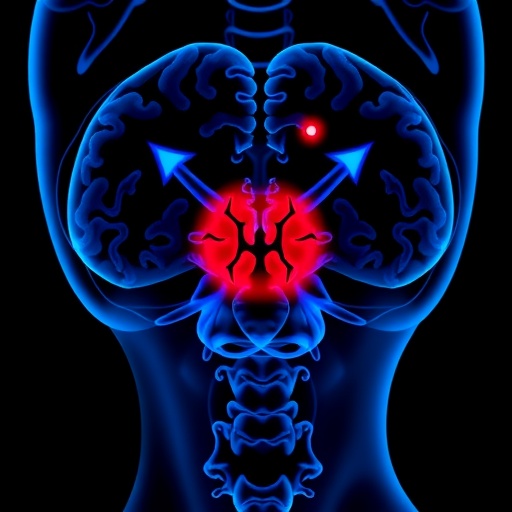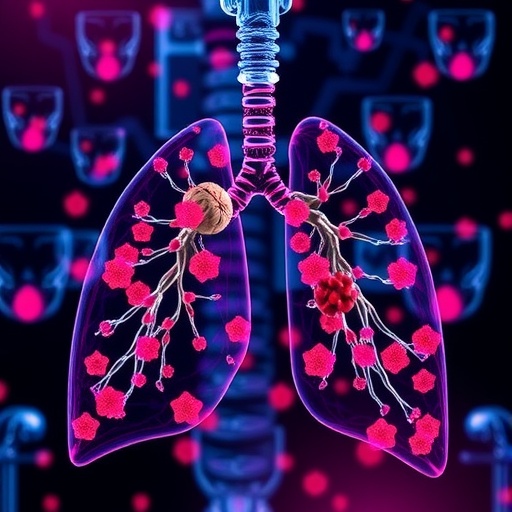In the rapidly evolving landscape of cancer therapeutics and inflammation research, natural bioactive compounds are increasingly capturing the scientific spotlight. A recent groundbreaking study published in Medical Oncology delves into the potent anti-cancer and anti-inflammatory properties of bioactive compounds derived from Typhonium flagelliforme, an intriguing tropical plant. Leveraging cutting-edge in silico methodologies, the research zeroes in on the molecular mechanism involving NEK7, a protein kinase known to play critical roles in cell cycle regulation and inflammatory pathways. This study sets a new precedent, blending traditional ethnobotanical knowledge with modern computational biology to decode complex biological interactions that could spearhead innovative drug discovery.
The investigation begins by situating Typhonium flagelliforme within the context of global efforts to discover novel therapeutic agents. Often referred to as the “rodent tuber” or “Keladi Tikus,” this plant has been used in traditional medicine, particularly in Southeast Asia, for centuries. However, its precise molecular mechanisms remained elusive until now. Researchers employed advanced in silico modeling techniques to explore how the plant’s constituents interact with NEK7, a serine/threonine-protein kinase intimately involved in the progression of various cancers as well as in the activation of the NLRP3 inflammasome, a key regulator of inflammation.
Delving into the molecular dynamics simulations, the study employed sophisticated docking studies to predict the binding affinities of multiple bioactive compounds extracted from Typhonium flagelliforme. These compounds exhibited significant interaction potential with the active sites of NEK7, suggesting robust inhibitory capabilities. Among the myriad phytochemicals, several demonstrated a high binding affinity, indicating their strong likelihood to modulate NEK7’s activity effectively. What is especially striking is the dual role these compounds may play—simultaneously thwarting unchecked cellular proliferation and dampening chronic inflammatory responses, both hallmarks of numerous pathological states.
Understanding NEK7’s role in oncogenesis provides critical insights into why targeting this kinase may revolutionize cancer treatment. NEK7 is pivotal during mitosis, particularly in centrosome duplication and spindle formation, processes that, when dysregulated, can lead to chromosomal instability—a cancer hallmark. By demonstrating that natural compounds from Typhonium flagelliforme can bind to and potentially inhibit NEK7, the researchers highlight a promising therapeutic avenue. This natural inhibition could attenuate tumor progression by arresting aberrant cell division, providing a compelling alternative to synthetic small molecule inhibitors that often come with debilitating side effects.
Moreover, the intersection of NEK7 activity with inflammatory pathways opens exciting possibilities beyond oncology. NEK7’s function as an essential mediator of the NLRP3 inflammasome complex implicates it heavily in inflammation-driven diseases. Chronic inflammation is a recognized contributor to tumorigenesis, creating a vicious cycle that exacerbates disease progression. The study’s revealing data suggest that Typhonium flagelliforme compounds could directly suppress such inflammation, thereby not only halting tumor growth but also inhibiting the inflammatory milieu that fosters neoplastic development.
The in silico approach utilized in this research epitomizes modern drug discovery paradigms. By computationally screening vast libraries of phytochemicals for their interaction profiles against specifically chosen targets, scientists substantially reduce the cost and time associated with laboratory-based experiments. This strategy enables high-throughput identification of promising lead compounds with optimal binding efficiencies and pharmacokinetic properties. The computational tools used here ranged from molecular docking to dynamic simulations that simulate the behavior of molecules within a biological environment, ensuring the biological relevance of the findings.
Significantly, this study goes beyond mere computational predictions by integrating molecular docking scores with structural biology insights. By analyzing the three-dimensional conformations and interaction maps of the bioactive compounds with NEK7, the researchers identified critical residues involved in binding and inhibition. These amino acid residues, particularly within the ATP-binding pocket of NEK7, provide key targets for rational drug design, allowing chemists and pharmacologists to optimize these natural compounds further or design more potent analogs.
One of the most compelling aspects of this work is its emphasis on pluripotent bioactivity. Unlike monoclonal agents that target a single pathway, Typhonium flagelliforme’s compounds exhibit polypharmacology—the ability to modulate multiple signaling cascades simultaneously. This multifaceted interaction landscape is vital in cancer and inflammation, diseases fueled by intricate, redundant signaling networks. The compounds’ ability to engage NEK7 and potentially other related kinases or inflammasome components positions them as promising candidates for multi-target therapeutic strategies.
While the computational findings are robust, the paper also acknowledges the necessity of subsequent wet-lab and in vivo validations to establish pharmacological efficacy, toxicity profiles, and dosage parameters. These follow-up steps are critical to translating in silico promises into clinical realities. Nonetheless, the present study lays a substantive groundwork, providing valuable lead compounds for preclinical testing and furnishing detailed molecular blueprints that can guide future medicinal chemistry endeavors.
This research underscores an emerging trend in oncological and immunological drug discovery—leveraging nature’s reservoir of chemical diversity with the precision of computational biology. The marriage of traditional botanical knowledge with state-of-the-art bioinformatics and structural genomics offers a fertile ground for breakthroughs. The excitement surrounding Typhonium flagelliforme’s bioactive compounds could galvanize a wave of investigations into other underexplored botanicals, revealing hidden pharmacopeias that modern science is only beginning to understand.
Further exploration of these compounds may also illuminate their role in overcoming resistance mechanisms that plague current cancer therapies. Tumor cells frequently evolve or adapt to evade mono-target drugs, resulting in treatment failure. The polyvalent action of Typhonium flagelliforme compounds on NEK7-driven oncogenic and inflammatory circuits could mitigate such resistance, leading to more durable clinical responses. Moreover, their natural origin may confer favorable biocompatibility and reduced toxicity, addressing side effect concerns that limit many chemotherapeutics.
Beyond cancer and inflammation, NEK7’s biological implications extend into neurodegenerative diseases and autoimmune disorders, conditions increasingly linked to dysregulated inflammasome activation. The inhibitory profile of Typhonium flagelliforme’s compounds against NEK7 might therefore hold therapeutic promise across a broader spectrum of diseases, inspiring a paradigm shift in targeting kinase and inflammasome pathways via plant-derived agents.
Critically, the study highlights the importance of integrating multidisciplinary expertise—from ethnobotanists and molecular biologists to computational scientists and clinicians—to accelerate drug discovery pipelines. This holistic approach enhances understanding of complex biological systems and streamlines translation from bench to bedside. By elucidating the molecular underpinnings of Typhonium flagelliforme’s effects, the research exemplifies how collaboration can unlock novel solutions to some of medicine’s most intractable challenges.
In conclusion, this pioneering investigation into the anti-cancer and anti-inflammatory potential of Typhonium flagelliforme bioactive compounds, centered around NEK7 inhibition, represents a significant leap forward in natural product drug discovery. It not only opens new scientific vistas for targeting key molecular drivers of disease but also reinforces the continuing relevance of herbal medicine in modern therapeutics. As the global burden of cancer and chronic inflammation escalates, such innovative research offers a beacon of hope, promising next-generation, nature-inspired treatments that combine efficacy with safety.
Subject of Research: Anti-cancer and anti-inflammatory activities of natural bioactive compounds of Typhonium flagelliforme targeting NEK7.
Article Title: Deciphering the anti-cancer and anti-inflammatory activity in natural bioactive compounds of Typhonium flagelliforme: in silico approaches with special target to NEK7.
Article References:
Khan, S., Khan, SUD., Vohra, S. et al. Deciphering the anti-cancer and anti-inflammatory activity in natural bioactive compounds of Typhonium flagelliforme: in silico approaches with special target to NEK7. Med Oncol 42, 495 (2025). https://doi.org/10.1007/s12032-025-03035-2
Image Credits: AI Generated
Tags: bioactive compounds anti-inflammatory propertiescancer therapeutics and inflammationcomputational biology in drug developmentin silico modeling cancer therapyinnovative drug discovery methodsmolecular mechanisms of Typhonium flagelliformeNEK7 protein kinase roleNLRP3 inflammasome activationrodent tuber ethnobotanical significanceSoutheast Asian medicinal plantstraditional medicine novel therapeuticsTyphonium flagelliforme cancer research





